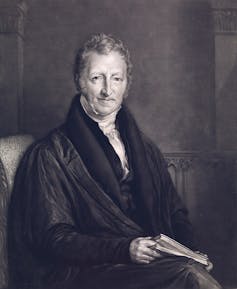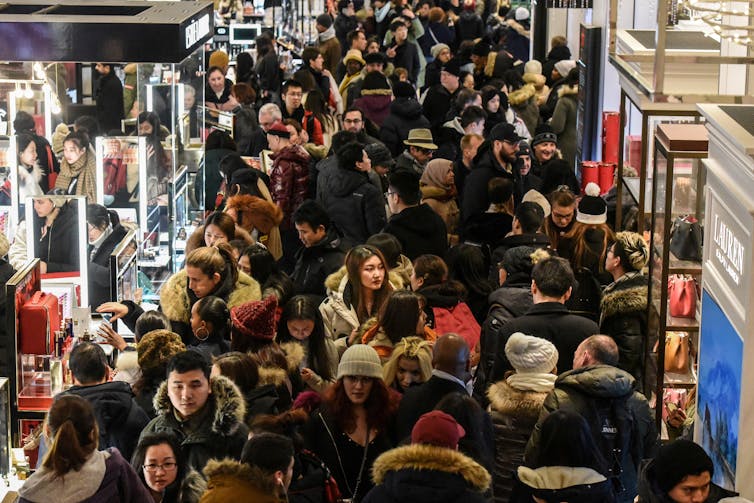A country can never be too rich, too beautiful or too full of people
- Written by Jay L. Zagorsky, Senior lecturer, Boston University
“Our Country is FULL!” U.S. President Donald Trump recently tweeted[1].
He was referring to immigrants, but the rhetorical tweet begs the question: Can a country ever be full?
Economists like me have been[2] arguing for centuries about the question but also a closely related one: Is a growing population good or bad?
A country’s ‘carrying capacity’
The first economist to suggest there were limits to how many inhabitants a country could support was Thomas Malthus, who wrote his most famous work, “An Essay on the Principle of Population[3],” in 1798.
Malthus believed that each country had a “carrying capacity,” a maximum number of people it can support. When the population is above its carrying capacity, it is full.
 Thomas Malthus.
John Linnell/Welcome Collection, CC BY[4][5]
Thomas Malthus.
John Linnell/Welcome Collection, CC BY[4][5]
Carrying capacity[6] is based on environmental factors, such as the amount of food resources that can be grown on land or harvested from the sea. If Malthus were alive today, he would point out there is a fixed amount of oil in the Earth and a fixed amount of farmland[7] to grow crops. Sooner or later the oil will run out[8], and if population grows without bound, there will not be enough food to feed everyone.
Malthus’ predictions about what happens after a country rises above its carrying capacity were dire: Disease, famine and wars break out to bring the population back down to a sustainable level. In simple terms, Malthus’ theory was that the population in a country cannot grow indefinitely. Death will constrain it.
This harsh conclusion is one of the reasons people began calling economics the “dismal science[9].”
Another doomsayer, though not an economist, is author Jared Diamond, whose popular book “Collapse[10]” showed numerous times in history when population growth led to environmental damage that destroyed a society. The damage occurred because ever-increasing population forced people to move onto marginal or unsafe lands.
Supporters of Diamond’s ideas point out the problems that occur as an ever-growing population builds homes, businesses and farms in flood zones[11] and seeks shelter in places like the sides of active volcanoes[12].
The more, the wealthier
Many other economists hold the opposite view and argue population growth fosters economic progress, which means an ever-growing amount of goods and services.
Some of the early work was done in the 1990s by the late Julian Simon[13]. He stressed the idea that a growing population is advantageous because it means more researchers, inventors, thinkers, writers and creative people contributing to economic growth.
These kinds of ideas were expanded by people like Harvard development economist Michael Kremer[14], who suggested it takes a critical mass of people for advanced societies to develop. Societies with high population densities are the most dynamic and most productive, while societies with low densities are not.
The reason why large populations are good is straightforward. Few ideas come from people who are isolated. Numerous people who are together in close proximity produce more ideas because they learn from each other and compete.
Proponents of population growth[15] point out[16] most of the new ideas and products come from cities like New York City, London and Paris. The places brimming with ideas are dense, crowded major urban centers teeming with people. These major cities act as a magnet for people[17] with talent who are then able to thrive.
 As Black Friday shows, more people means more spending and more economic growth.
Reuters/Stephanie Keith[18]
As Black Friday shows, more people means more spending and more economic growth.
Reuters/Stephanie Keith[18]
Far from full
When Malthus kicked off the debate over population, the U.S. had about 4 million people. Today the U.S. has almost 330 million[19].
This dramatic growth has caused neither collapse nor devastation in the U.S.
Nevertheless, economists, politicians and others will continue to worry that sooner or later that population growth will outstrip the ability of humans to invent ways to sustain it.
My personal belief, after traveling to exceptionally dense cities[20] and many rural areas of America[21], is that the U.S. is not close to full and that barring immigrants will only stymie economic growth[22].
References
- ^ recently tweeted (twitter.com)
- ^ like me have been (businessmacroeconomics.com)
- ^ An Essay on the Principle of Population (www.econlib.org)
- ^ John Linnell/Welcome Collection (en.wikipedia.org)
- ^ CC BY (creativecommons.org)
- ^ Carrying capacity (www.sciencedirect.com)
- ^ fixed amount of farmland (www.nass.usda.gov)
- ^ oil will run out (peakoilbarrel.com)
- ^ dismal science (www.investopedia.com)
- ^ Collapse (www.jareddiamond.org)
- ^ in flood zones (www.usnews.com)
- ^ sides of active volcanoes (www.usatoday.com)
- ^ Julian Simon (press.princeton.edu)
- ^ Michael Kremer (www.jstor.org)
- ^ Proponents of population growth (www.economist.com)
- ^ point out (www.irishexaminer.com)
- ^ act as a magnet for people (assets.kpmg)
- ^ Reuters/Stephanie Keith (pictures.reuters.com)
- ^ 330 million (www.census.gov)
- ^ to exceptionally dense cities (u.osu.edu)
- ^ rural areas of America (blogs.bu.edu)
- ^ stymie economic growth (theconversation.com)
Authors: Jay L. Zagorsky, Senior lecturer, Boston University


